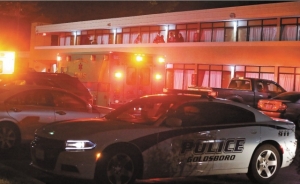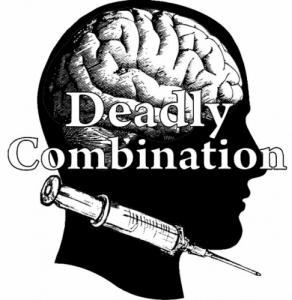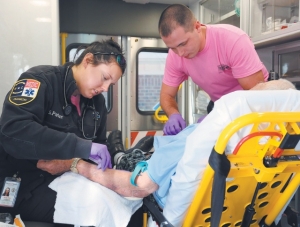Deadly Combination Part I -- The Casualties: On the front lines - EMS and law enforcement
By Ethan Smith
Published in News on December 6, 2017 5:50 AM

News-Argus/CASEY MOZINGO
The Goldsboro Police Department and Wayne County EMS respond to a fatal overdose call at Knights Inn, formerly Serena Inn, earlier this November.

News-Argus/CASEY MOZINGO

News-Argus/CASEY MOZINGO
Skylar Parker and Jeremiah Goodson administer an IV on a patient before taking him to Wayne UNC Health Care for treatment.
A police cruiser sits at the side of the road.
The car's blue lights flash against the black backdrop of the early morning darkness.
The car that has been pulled over is dark, too. Inside, the officer can see the driver moving erratically.
The driver may be pulling a gun. He or she could be stashing drugs.
Any police officer will likely agree that one of the most dangerous aspects of the job is the "routine traffic stop."
It only takes an instant for the "routine" to become the extreme.
Police say some suspects have taken to trying to break up heroin, smearing it into their car's carpet or seats to dispose of it. The cloud that rises, or the traces left of the potent drug, can get on a police officer's skin and absorb into their bloodstream.
"We've got the issue where some of these dealers we've stopped carry it raw powder -- not bagged up -- it's actually like a bought piece of heroin," said Detective Sgt. Chuck Shaeffer with the Wayne County Sheriff's Office. "And when you stop them, the first thing they do is crush it and throw it, and it's all over the car. So when you go to search that car, you've got heroin dust laying everywhere in the car."
This means officers can collect less evidence, and it lessens the weight of the charge against a suspect.
Add to that the fear of the unknown, a new danger, brought about by the ongoing heroin epidemic plaguing the nation's cities and towns -- the rise of fentanyl and other additives to the drug.
Goldsboro Police Capt. G.N. Lynch, a 20-plus year veteran of the force, spoke candidly about the dangers the drug poses to officers in the field.
"With the fentanyl now, a heroin user has that limit or that tolerance built up to it -- I don't," Lynch said. "A little bit could get on him, and it's not going to bother him at all. I get a little bit on me, and it could kill me."
COMBATING THE EPIDEMIC
Lynch heads the Goldsboro Police Department's VICE Unit. He says that 20 years ago, heroin wasn't on law enforcement's radar. The city ---- and country ---- was at that time battling the crack epidemic.
Stopping the flood of heroin from hitting the city's and county's streets is a complicated undertaking. The heroin seems to be coming into the area from all different directions, where it used to just flow in from one or two places.
"One of our issues in years past is most of our heroin came from up north," Lynch said. "It would come from New Jersey and New York, but now we're getting it from north and south -- from Atlanta to this way, plus (New) Jersey. It's a hard battle to look at."
Despite all of this, Goldsboro police are doing everything they can in the city to combat the growing problem.
The rate of overdoses in the city started gaining speed early this summer and has kept going.
"June is where we started picking up the pace," said Goldsboro Police Chief Mike West. "June, July, August and September all exceeded those same months last year."
The trend shows no signs of slowing down either. And the more deadly the heroin, the more likely people are to seek it out.
"What I've seen since I've been in this unit is you get a dirty batch of something on the street and everybody flocks to that dirty batch, because it's like, 'Hey, this is the best high I've ever had,'" Lynch said.
"To me and you, it makes no sense, but to them it makes all the sense in the world because they're chasing that first high they ever had off of it."
Because of dirty batches -- heroin mixed with fentanyl, carfentanil and other high-potency drugs -- police have had to change the way they handle drugs when they come across them.
Fentanyl is 50 to 100 times more powerful than morphine. Carfentanil, invented as an elephant tranquilizer, is even stronger still -- it is up to 10,000 times stronger than morphine.
Officers used to be able to conduct field tests on any suspected heroin, but with the risk of negatively affecting their own health, they can't do that today.
Officers now wear gloves and masks when seizing suspected narcotics, because fentanyl can be absorbed through the skin, potentially causing an immediate overdose in someone with no tolerance to the drug.
Detective Sgt. Chuck Shaeffer, assigned to the Wayne County Sheriff's Office Drug Squad, said it is also impossible for officers to know exactly what is in the heroin.
"If they buy it, and it's pre-cut, they don't know what it's cut with when they get it," Shaeffer said.
Not all the heroin dealers are necessarily buying pure heroin and are compounding the toxicity by cutting it themselves with whatever they want to and then selling it.
"They're getting it, it's already cut and then they may step on it or add something else to it to cut it even more," Shaeffer said
Detective Joseph Borgquist, also with the Wayne County Sheriff's Office, said he's sent samples off to the State Bureau of Investigation crime lab to be tested, and some come back as straight fentanyl without any presence of heroin.
THE CASUALTIES
Law enforcement and paramedics are coming in contact with heroin and its victims almost daily. And unlike with the crack era, or at least its associated perception that the drug stereotypically impacted the black community more than others, opioid abuse and addiction knows no racial barriers.
"I'd say a year ago it was predominantly white males, lower 20s. Now, it's open to basically any race, any sex," Lynch said. "Early 20s, 30s, I've seen some right on up in the 40s here lately."
The city alone has recorded more than 85 overdoses so far this year, having eclipsed in late-September the total number of overdoses for all of 2016 at 66. So far, only one of this year's overdoses in the city proved fatal.
"We worked a wreck one day that the guy shot up heroin driving down the road. The heroin hit him like a sack of bricks, he wrecked his vehicle going down the road, wrecked it into another vehicle, so now there's two patients," said paramedic Jeremiah Goodson. "This gentleman is out of the vehicle -- someone pulled him out -- he's very blue in the face, he lost his respiratory status and loses his pulse, so legally he died."
But Goodson did what any paramedic would do and he began CPR. He intubated the patient and starting pushing Narcan -- the antidote for an opioid overdose.
And then he kept pushing Narcan.
"We had used four milligrams and were fixing to push another two milligrams," Goodson said.
His perseverance paid dividends as the victim regained consciousness.
"It's an awesome feeling when they start breathing," Goodson said.
On the other side of the spectrum are the dealers and the struggles that law enforcement officers encounter when trying to prosecute them.
Lynch said pill cases are one story -- it doesn't take a lot to mandate a trafficking amount and give the accused a mandatory prison sentence if convicted. The challenge comes with more dealers popping up in the place of those taken down by the police.
"One of the guys, we haven't secured warrants on him yet, but I mean he's -- we could call him up and get any amount of any kind of pain pill we want," Lynch said. "I don't know where he's getting them from. Hopefully we'll find that out before too long, but it's a never ending cycle. Once we take him down, there's going to be two more to take his place."
But heroin -- that's an entirely different beast. It is more difficult to root out at the source. Because the drug is so powerfully addicting and the high is so strong, addicts are reluctant to give up who gave it to them.
"A heroin junkie is not going to give up their supplier. Not gonna do it," Lynch said. "They might give up somebody that they used to use, but they're not going to give up their current suppliers, because that's their fix. That's who they go to every day. A heroin junkie and anybody else -- a crackhead, anybody else -- they're two totally separate animals. A heroin person is not going to give up their supplier."
Borgquist elaborated further, moving on to what sometimes happens when a suspected dealer is charged. He pointed to low bonds and light sentences as insufficient deterrents to selling drugs.
"If you lock up a heroin dealer, there's no consequences for them," Borgquist said. "We've locked up one guy multiple, multiple times for trafficking heroin, and he's said he's going to keep doing it, because he bonds out and keeps doing it. So how do you fight that?"
ADDICTION TAKES HOLD
Wayne County EMS workers often encounter volatile scenes and tragic situations while trying to treat an overdose.
They've seen mothers and sons overdose together, stepdaughters and stepfathers, husbands and wives.
"We went to one where the wife ---- and the man was gray -- long story short, we used Narcan and bagged him and the whole nine yards again, and meanwhile, the wife is running around and grabbing all the heroin needles and trying to hide them from the police department," Goodson said.
Medics have gone to calls where addicts will allow one user to shoot up heroin and when they start to overdose, revive them with Narcan. Then they will switch places and shoot heroin themselves and allow the person coming out of an overdose to use Narcan to revive them.
And worse ---- more traumatic than having to see parents use with their adult children, or coming across siblings or couples who shoot up together ---- is responding to a teenager overdosing and arriving too late.
"The youngest overdose this year was 14," said paramedic Natasha Kelly. "That 14-year-old did not make it. The 14-year-old went to my daughter's school. Apparently, it was known he had issues, but they didn't know what kind of issues until he overdosed on heroin."
AN ENDLESS CYCLE
Much like those who buy and use heroin and other opioids, there is also no blanket demographic for who is selling it.
Lynch and West said they could not speak to whether or not gangs were involved, but said some sellers are people regularly in and out of jail. Others are people with no criminal history.
And users, too, are being more bold about their use with Narcan, which is now being sold over the counter.
Lynch recalled a traffic stop in which two brothers admitted to having heroin -- and Narcan -- in the car.
"They told me right to start off with, 'I got needles and Narcan in the glove box, you're more than welcome to look,'" Lynch said. "And they did, they had two vials of Narcan. I'm not condoning it by any means, but they were responsible heroin users. They were prepared to look out for each other when they were doing heroin."
But even responsible users can overdose. As users become more adept at staying alive, despite the increasing potency of the drugs they are ingesting, the number of overdoses will continue to increase.
That means that law enforcement, first responders and hospital emergency rooms will continued to have to treat these victims, likely over and over again. Meanwhile, the revolving door of the criminal justice system continues to spin.
"It's a cycle. And it's going to keep going until the next big thing comes," Lynch said. "We're doing everything we can to combat it, just like the (recently seized) 10 pounds off the street, but, ultimately you're hurting in the long run, too, because you have 10 pounds off the street over here and then your overdoses kick up because of the means they're taking to distribute what they have left."
